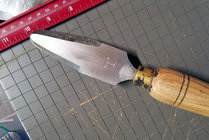- Joined
- Apr 27, 2004
- Messages
- 9,243
- Likes
- 5,903
- Location
- Lakeland, Florida
- Website
- www.hockenberywoodturning.com
After reading @egsiegel s post in another thread, I got to thinking about when it doesn’t make sense to try a new technique.
Made me wonder about a post I made about how using the Flute up shear cut cut on the inside of the bowl reduced sanding for me significantly. This is a difficult cut to master without a teacher. @Doug Freeman experience leads him to call it the suicide cut - a term I had not heard before. I was lucky to have learned the cut in a class with Liam O’Neil and to have it reinforced in a class with David Ellsworth.
The problem with an experienced turner trying the flute up shear cut without a class or mentor is they may never get beyond the Suicide experience.
They may ruin pieces trying and time spent learning will be lost production they may never regain in reduced sanding time in the future.
I visited with Myron Curtis( a legend in Tidewater Virginia). Myron had these huge lathes for architectural turning most of which he did with 1/4” scrapers.
We talked about choices of tools. Myron told me he though he could get a better surface with a gouge but didn’t think it would be any faster. His reluctance to seitch to gouges was his loss of income in the month or 2 it would take for him to get proficient with gouges.
Similar to Myron
I had to turn a large platter a couple of years ago and I experimented with the 40/40 and actually made 3 platters.
Definitely put a nice surface on the slightly curved platters. I’ll use the 40/40 if I do more platters.
Don’t think I’ll use it to hollow a bowl.
So when are we too set in our ways to try new things.
I was anti carbides until two things happened To convince me the tools were worth a try.
1 a company gave me a #4 Hunter tool
2 @john lucas shared his experience and videos with the Hunter carbides.
Tried it hollowing a couple of goblet bowls…. Sold.
Made me wonder about a post I made about how using the Flute up shear cut cut on the inside of the bowl reduced sanding for me significantly. This is a difficult cut to master without a teacher. @Doug Freeman experience leads him to call it the suicide cut - a term I had not heard before. I was lucky to have learned the cut in a class with Liam O’Neil and to have it reinforced in a class with David Ellsworth.
The problem with an experienced turner trying the flute up shear cut without a class or mentor is they may never get beyond the Suicide experience.
They may ruin pieces trying and time spent learning will be lost production they may never regain in reduced sanding time in the future.
I visited with Myron Curtis( a legend in Tidewater Virginia). Myron had these huge lathes for architectural turning most of which he did with 1/4” scrapers.
We talked about choices of tools. Myron told me he though he could get a better surface with a gouge but didn’t think it would be any faster. His reluctance to seitch to gouges was his loss of income in the month or 2 it would take for him to get proficient with gouges.
Similar to Myron
I saw Stuart this weekend at Totally Turning in Saratoga.
heard is explanation of 40/40 and have stuck with my conclusion that if I was starting out, I'd probably try it and adopt it.
but after 40 years of turning....I'm pretty comfortable with my grinds for my basic tools (gouges, skew, etc.) and it does not make sense to change.
I had to turn a large platter a couple of years ago and I experimented with the 40/40 and actually made 3 platters.
Definitely put a nice surface on the slightly curved platters. I’ll use the 40/40 if I do more platters.
Don’t think I’ll use it to hollow a bowl.
So when are we too set in our ways to try new things.
I was anti carbides until two things happened To convince me the tools were worth a try.
1 a company gave me a #4 Hunter tool
2 @john lucas shared his experience and videos with the Hunter carbides.
Tried it hollowing a couple of goblet bowls…. Sold.
Last edited:

